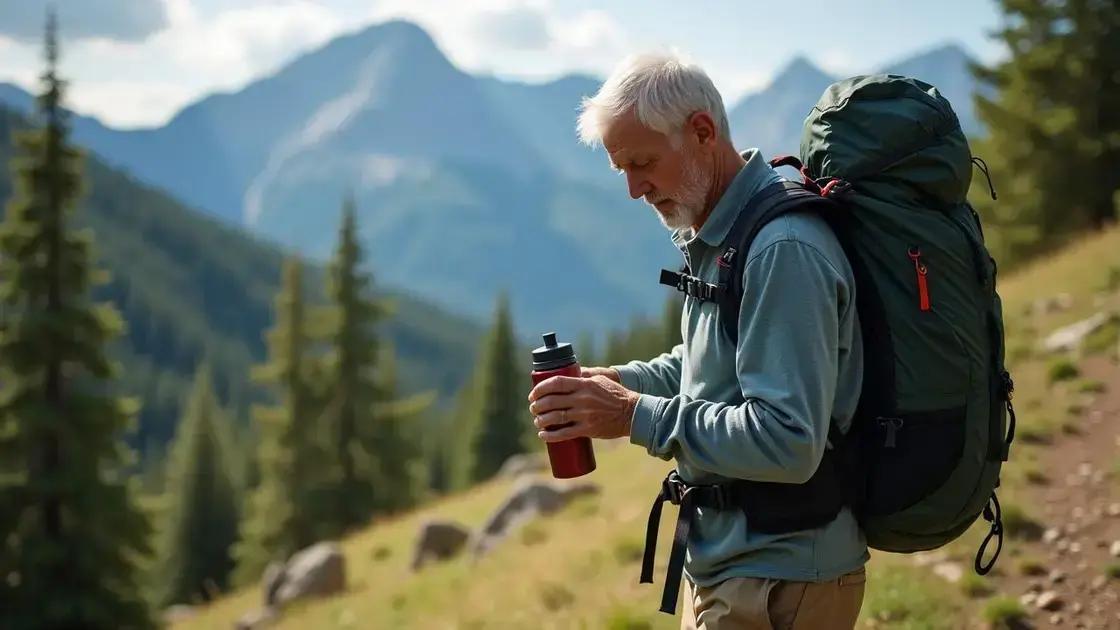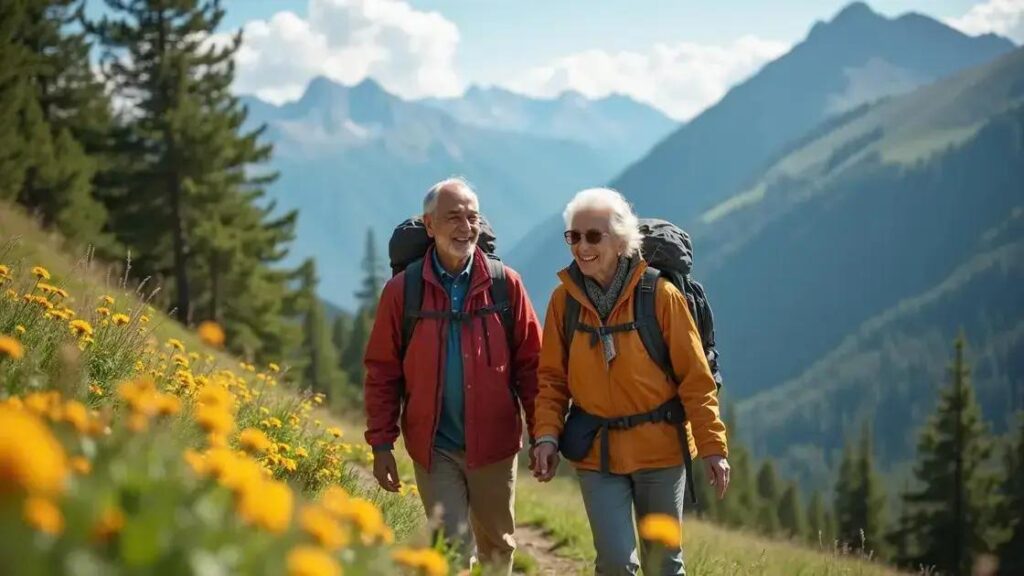Preparing for hiking adventures after 50 involves choosing appropriate trails, gathering essential gear, engaging in targeted exercises, and focusing on proper nutrition to ensure a safe and enjoyable experience while enhancing physical and mental well-being.
If you’re over 50 and dreaming of hiking adventures, you might wonder how to get started. Hiking is not just a great way to stay fit, but it also helps connect you with nature and boosts mental health. In this guide, we’ll cover essential training tips, effective exercises, and the best nutrition advice to help you prepare for amazing hiking experiences.
Understanding the Benefits of Hiking After 50

Hiking after 50 offers numerous benefits that contribute to both physical and mental well-being. As people age, maintaining an active lifestyle becomes crucial for health. Hiking is a perfect way to stay active while enjoying nature.
Physical Health Benefits
One of the main benefits of hiking is enhanced physical fitness. Hiking helps improve cardiovascular health by increasing heart rates and circulation. It also strengthens muscles, especially in the legs, core, and back, which is vital for maintaining balance and stability as we age.
Mental Health Advantages
Hiking can significantly boost mental health. Being in nature has calming effects that reduce stress and anxiety. Additionally, hiking encourages mindfulness and helps alleviate symptoms of depression. Engaging with the environment also enhances overall mood and promotes a sense of accomplishment.
Social Connections
Participating in hikes can also foster social connections. Joining local hiking groups or clubs provides an opportunity to meet new people who share similar interests. Engaging socially while hiking helps counter feelings of isolation and builds a supportive community.
Greater Mobility and Flexibility
Regular hiking promotes better overall mobility and flexibility. Navigating different terrains helps improve coordination and strengthens joint function. This is especially beneficial for older adults, as it helps maintain functional independence.
With these benefits, hiking becomes an excellent option for those over 50 looking to maintain and improve their health while exploring the beauty of the outdoors.
Essential Training Exercises for Hikers

To prepare for hiking adventures, it is vital to incorporate essential training exercises that enhance strength, endurance, and balance. This training will boost your hiking performance and help prevent injuries.
Squats
Squats are an excellent exercise for building strength in your legs and core. To perform a squat, stand with your feet shoulder-width apart. Lower your body by bending your knees and pushing your hips back, as if you’re sitting in a chair. Keep your chest up and go as low as you can while maintaining good form. Aim for 3 sets of 10-15 repetitions.
Walking Lunges
Walking lunges help improve leg strength and balance. Start standing tall, then step forward with your right leg, lower your hips until both knees are bent at about 90 degrees. Your back knee should hover just above the ground. Push through your front heel to return to standing and switch legs. Repeat this for 10 lunges on each side.
Plank
The plank exercise strengthens the core, which is essential for maintaining stability on uneven trails. Get into a push-up position, resting on your forearms instead of your hands. Keep your body straight and hold this position for as long as you can, aiming for 30 seconds to 1 minute. Remember to breathe and engage your core throughout the exercise.
Step-Ups
Step-ups are great for building power in your legs. Use a bench or sturdy step. Place your right foot on the step, pushing through your heel to lift your body up. Bring your left foot up to the step, then step back down with your left foot followed by your right. Do 10-15 repetitions on each leg.
By including these exercises in your routine, you will prepare your body for the demands of hiking, making your experience more enjoyable and safe.
Nutrition Tips for Hiking at Any Age

Nutrition plays a vital role in preparing for hikes at any age. To maintain energy levels and ensure safety, focus on nourishing your body properly.
Stay Hydrated
First and foremost, hydration is essential. Always carry enough water and drink regularly, even if you are not feeling thirsty. Aim for at least 2 liters of water on a hike, more if it’s hot or if you are hiking longer distances.
Carbohydrates for Energy
Choose complex carbohydrates to fuel your hikes. Foods like whole-grain bread, brown rice, and oats release energy slowly, keeping you energized over time. Pack snacks like granola bars, trail mix, or banana chips to maintain your energy levels during the hike.
Protein for Muscle Repair
Including protein in your meals helps with muscle repair after hiking. Opt for lean meats, nuts, and legumes. These foods not only provide protein but also essential vitamins and minerals that support overall health.
Healthy Fats for Sustained Energy
Don’t shy away from healthy fats; they are crucial for long hikes. Include sources like avocados, olive oil, and nut butters. These fats provide concentrated energy that can help keep your stamina high during longer treks.
Plan Your Meals
Before your hike, planning your meals is key for successful nutrition. Eating a well-balanced meal that includes carbohydrates, protein, and healthy fats will keep your body ready for physical activity. Make sure to try out new foods before the hike to see how your body responds.
By following these nutrition tips, you’ll ensure you’re well-fueled and ready to enjoy your hiking adventures at any age.
Preparing for Your First Hiking Trip After 50

When preparing for your first hiking trip after 50, planning is essential to ensure a safe and enjoyable experience. Here are important steps to take.
Choose the Right Trail
Select a hiking trail that matches your fitness level and interests. Look for beginner-friendly paths that are well-marked and have gradual terrain. Research the trail conditions and read reviews from other hikers to ensure it’s suitable.
Gather Essential Gear
Proper gear is critical for comfort and safety. Invest in good-quality hiking shoes that fit well to prevent blisters. You’ll also need a backpack, water bottle, first aid kit, and weather-appropriate clothing. Don’t forget a map or GPS device to help with navigation.
Hike with a Buddy
Hiking with a friend or family member can be motivating and safer. Having someone with you can help in case of an emergency. You can also share the joy of hiking experiences, which enhances the enjoyment.
Practice Before Your Trip
Before your first hiking adventure, practice walking on uneven surfaces. This will help your body adjust to the movements needed during a hike. Start with short walks and gradually increase the distance and difficulty.
Know Your Limits
As you hike, listen to your body. Know when to take breaks and stay hydrated by drinking water regularly. Don’t feel pressured to keep up with faster hikers; enjoy the journey at your own pace.
By following these preparation tips, you will set yourself up for a successful first hiking trip after turning 50. Enjoy nature while staying safe and healthy.
Embrace the Outdoors at Any Age
Preparing for hiking adventures after 50 is an exciting journey that combines physical fitness, proper nutrition, and essential training.
By understanding the benefits of hiking, engaging in targeted exercises, and focusing on nutritious meals, you can ensure a safe and enjoyable experience.
Remember to choose the right trails, invest in proper gear, and hike within your limits. Most importantly, enjoy the beauty of nature and the sense of accomplishment that comes with each hike.
With the right preparation and mindset, hiking can be a rewarding activity that enhances well-being, social connections, and a love for the outdoors at any age.
FAQ – Frequently Asked Questions About Hiking After 50
What are the benefits of hiking after 50?
Hiking promotes physical fitness, enhances mental health, and provides opportunities for social connections while exploring nature.
How can I prepare for my first hiking trip after 50?
Choose an appropriate trail, gather essential gear, consider hiking with a buddy, practice on uneven surfaces, and know your limits.
What exercises should I do to prepare for hiking?
Focus on squats, walking lunges, planks, and step-ups to improve your strength, balance, and endurance.
What nutrition tips should I follow for hiking?
Stay hydrated, eat complex carbohydrates for energy, incorporate protein for muscle recovery, and include healthy fats for sustained energy.
How can I stay safe while hiking?
Always carry enough water, dress appropriately for the weather, let someone know your plans, and hike within your ability level.
Is it necessary to hike with a partner?
While it’s not mandatory, hiking with a partner can increase safety, provide motivation, and enhance the enjoyment of the experience.













